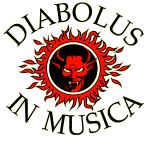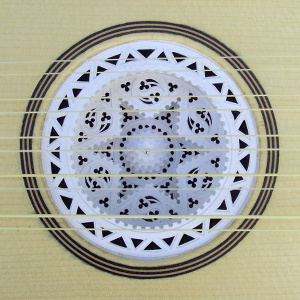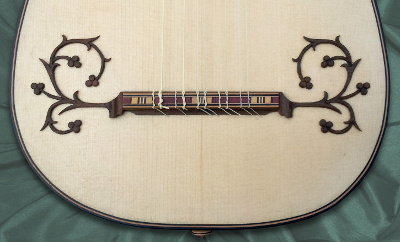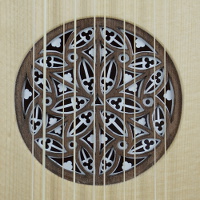
|
Baroque Guitar |

Baroque Guitar
The Baroque Guitar was common from the beginning of the 17th century to the late 18th. It has five double-strung courses. There is a substantial solo repertoire in tablature, but it was also used as a continuo instrument, improvising from figured bass, and for simple strummed accompaniments. The basic tuning is aa d'd' gg bb e'e' - the fourth and fifth courses are re-entrant. Two other tunings were commonly used - a low octave string on the fourth (aa d'd gg bb e'e') or on both fourth and fifth (aA d'd gg bb ee). Fortunately, changing tuning only means changing strings, so players are free to experiment. 
Multilayer Rose
My baroque guitars are based on plans of the Stradivarius in the Ashmolean Museum, and another in a private collection in Birmingham. String length varies widely on survivimg baroque guitars. The Ashmolean Stradivarius is 72cm, which many players, especially those with small hands, would find unmanageable. After consulting professional players, I scaled down all the dimensions to give a string length of 66.5cm. This is short enough for complex solo playing, but provides enough sustain to make it useful as a continuo instrument. String length can be varied to suit your preference, though. A prominent feature of the Baroque guitar (appropriately) is ornament. There were relatively plain examples, but many of the surviving baroque guitars have LOTS of inlay, deep multilayer roses, moustaches on the bridge, and all sorts of other frippery. Prospective purchasers will need to decide how much decoration they want. The pictures on this page show my standard model, which is decorative without being gaudy - nothing like the encrusted examples in some museums. 
Inlaid Head and Pegs

Bridge with moustaches and inlaid top

Back view

Plain Baroque Guitar

Simple Rose
Sound ClipsPlayed by Richard MacKenzie Tombeau de Charles (Sarabande) by Gallot D'Irlande From Richard's new album "Tombeaux - a secular requiem for my father".
Played by Ian Pittaway
Played by Ian Pittaway Prices
To order or enquire, pleasecontact me Cases - Excellent cases can be ordered from specialist manufacturers such as Kingham MTM, but they're pricy. I can supply an attractive, custom-built plywood case, black with chrome fittings, for £220 when ordered with an instrument. Delivery - the price depends on where you live. Please enquire. I hate it when websites say "Phone for a quote", so to give you some idea - getting a baroque guitar in its case to America, including insurance, is currently about £170. Getting one to Kent is about half that. Waiting time, from placing an order to clutching your new baby, is currently about 16 months. It's very approximate, because the schedule often contains items that are somewhat experimental, and they may take more or less time to complete than anticipated. Usually more. Deposit- I usually ask for £150 (non-returnable unless I'm dead, insane, incapacitated or incarcerated) to secure an order and cover materials. Once that's paid, your order is entered into my Magic Book. Nothing happens for several months, then you receive an email to tell you I've started construction. A few weeks later, a big parcel arrives, and you squeal with delight.
Anote on HUMIDITY - delicate wooden instruments are remarkably resilient, but
they can have major problems with both high and low atmospheric humidity levels. I keep my workshop at the
recommended humidity level, between 45% and 50%, and I strongly recommend that instruments are kept as close
to that range as possible. Electronic humidity meters are available cheaply on the Internet. They're small enough
to keep in your instrument's case. |
||||||
 More Instruments |
 Diabolus Homepage |
|
 Email for Diabolus |